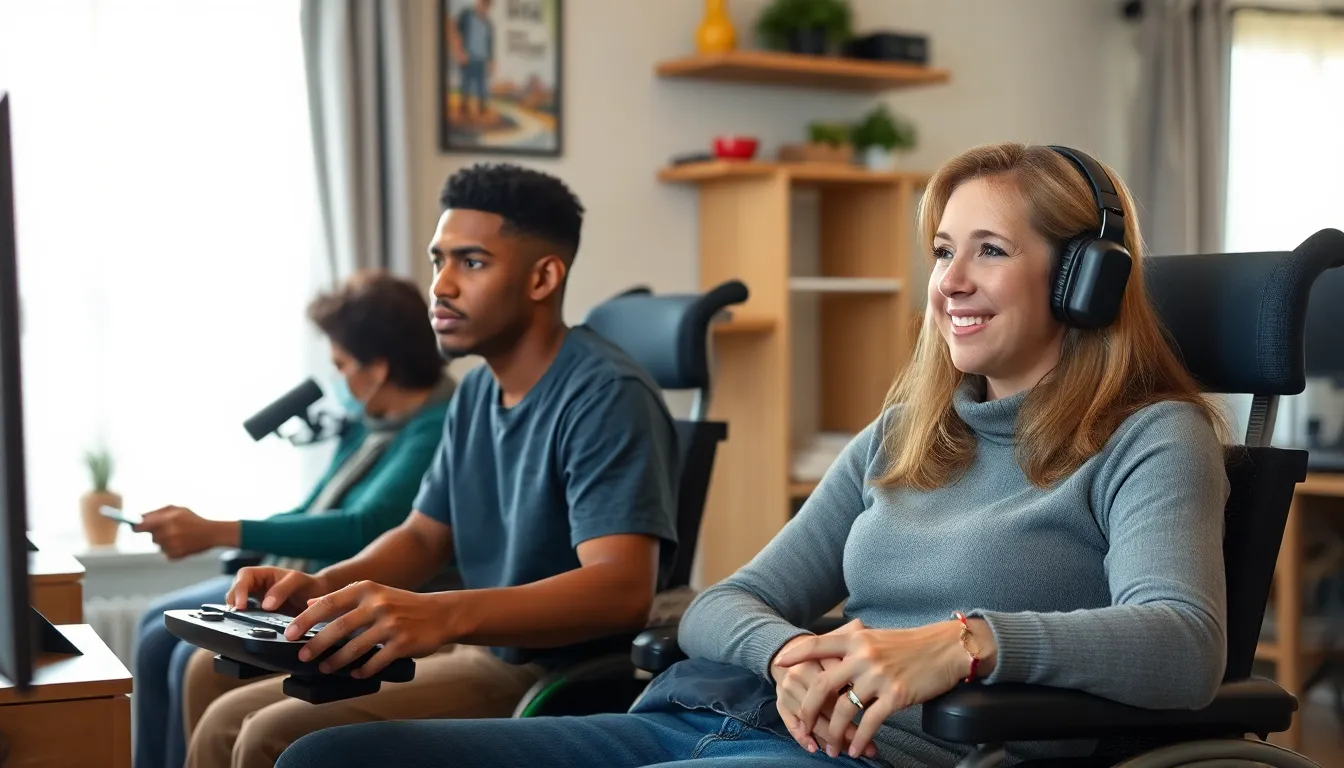Table of Contents
ToggleIn a world where gaming can feel as complicated as solving a Rubik’s Cube blindfolded, PC gaming stands out for its ease of access. Gone are the days of wrestling with outdated consoles or deciphering cryptic installation instructions. With a few clicks, anyone can dive into a universe of high-quality graphics and immersive gameplay—all from the comfort of their own desk chair (or couch, if they’re feeling rebellious).
Understanding PC Gaming Ease of Access
PC gaming has transformed accessibility, providing players with opportunities for high-quality engagement and enjoyable experiences. The contrast between past hurdles and the current seamlessness is remarkable.
Importance of Accessibility in Gaming
Accessibility plays a vital role in the gaming community. It ensures individuals with disabilities can fully participate in the gaming experience. A diverse player base fosters a richer gaming environment. Inclusion leads to innovation, inspiring developers to create games that resonate with a wider audience. Enhancing accessibility benefits everyone by promoting social interaction and community engagement.
Current Accessibility Features in PC Games
Many PC games now incorporate essential accessibility features. Visual options include colorblind modes and adjustable font sizes, which cater to various needs. Audio descriptions enhance gameplay for visually impaired players, while customizable controls allow users to adapt their experience. Many developers offer tutorials for new players, helping them familiarize themselves with gameplay. Integrated text-to-speech functions support communication among gamers. Continuous improvements in accessibility reflect a growing commitment from developers to create an inclusive gaming landscape.
Common Challenges Faced by Gamers

Games often become less accessible due to various challenges, impacting enjoyment for different player groups. Specific difficulties arise for those with physical disabilities and cognitive impairments.
Physical Disabilities
Players with physical disabilities encounter unique challenges in PC gaming. Standard controls may not suit everyone’s needs, making gameplay frustrating. Adaptations such as customizable controls or the use of adaptive hardware can enhance the experience. These solutions include ergonomic game pads and voice-command systems, which allow players to enjoy gaming without traditional hand controls. Many developers now prioritize accessible options, ensuring games accommodate a broad range of physical abilities.
Cognitive Impairments
Cognitive impairments present significant barriers in gaming for some individuals. Complex interfaces and intricate game mechanics may overwhelm players. Simplified menus and clear instructions can assist in navigating the gaming landscape. Games with adjustable difficulty settings also cater to varying skill levels, promoting enjoyment for all. Designers are increasingly aware of these needs, integrating features that support mental clarity and comprehension, creating an inviting atmosphere for diverse players.
Tools and Resources for Enhanced Accessibility
Gaming accessibility improves with various tools and resources designed for all players, especially those with disabilities. These resources enhance the gaming experience and promote inclusivity.
Adaptive Hardware
Adaptive hardware plays a crucial role in making gaming more accessible. Devices like customizable controllers allow players to configure buttons according to their preferences. Specialized gamepads cater to those with limited mobility, offering options like joystick modifications. Trackballs provide alternative navigation methods, making it easier for individuals with hand coordination challenges. Additional equipment, such as foot pedals and head tracking systems, further expands opportunities for all gamers to engage comfortably.
Software Solutions
Software solutions enhance accessibility through various innovative features. Colorblind modes let players customize color settings, ensuring they can distinguish in-game elements. Text-to-speech programs assist visually impaired individuals by reading on-screen text aloud. Adjustable font sizes aid readability, allowing players to find the perfect visual comfort level. Furthermore, customizable user interfaces enable players to tailor their gaming environments, promoting an enjoyable experience.
The Role of Game Developers
Game developers play a crucial part in making PC gaming more accessible. They integrate various accessibility features directly into games to enhance the experience for all players.
Incorporating Accessibility Features
Developers focus on implementing features that accommodate a range of abilities. Colorblind modes allow players with visual impairments to enjoy games without hindrance. Customizable controls enable users to tailor their input methods, ensuring comfort and usability. Adjustable font sizes benefit players who require larger text for readability. Audio descriptions enhance gameplay for those who are blind or visually impaired. Features like these exemplify the commitment to inclusive design that developers prioritize.
Community Feedback and Iteration
Developers actively seek feedback from the gaming community to improve accessibility. Community input provides valuable insights into players’ needs and challenges. Iteration based on this feedback helps refine accessibility features further. Engaging with players fosters a sense of belonging, ensuring everyone’s voice is heard. This collaborative approach enhances the overall gaming experience, allowing developers to create more inclusive environments. Regular updates demonstrate a dedication to ongoing improvement while staying attuned to player preferences.
Future of PC Gaming Accessibility
Advancements in technology continue to shape the future of PC gaming accessibility. Developers are increasingly focused on creating an inclusive environment where everyone can play.
Emerging Technologies
Voice recognition is gaining traction, allowing players to issue commands without traditional controls. Machine learning algorithms enhance adaptive hardware, making it easier for players with disabilities to customize gameplay to their preferences. Wearable devices, such as eye-tracking tools, offer new ways to interact with games, catering to those who might struggle with standard controllers. Virtual reality environments are also becoming more accessible, providing unique gameplay experiences that integrate adaptive features seamlessly. Gamers can expect continuous improvements as technology evolves to meet diverse needs.
Trends and Innovations
Inclusive design principles are becoming mainstream within the gaming industry. Developers prioritize accessibility from the early stages of game creation, ensuring features like adjustable difficulty and improved user interfaces are standard rather than additional. Community-driven development fosters collaboration, enabling players to share feedback that directly influences accessibility features. Additionally, funding and support for accessibility initiatives are increasing, reflecting a broader industry commitment to inclusivity. Overall, these trends ensure a richer gaming experience for everyone, regardless of ability.
The evolution of PC gaming accessibility marks a significant shift toward inclusivity and enjoyment for all players. With advancements in technology and a growing awareness of diverse needs, gaming has transformed into a welcoming space. Developers are not only integrating essential features but also actively seeking feedback to refine experiences further.
This commitment ensures that everyone, regardless of ability, can immerse themselves in captivating worlds and engaging gameplay. As the industry continues to embrace these changes, the future of PC gaming looks brighter than ever, promising exciting opportunities for players everywhere.






